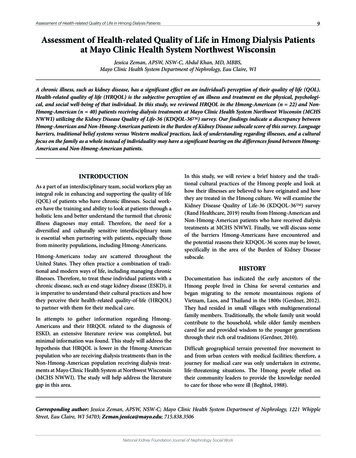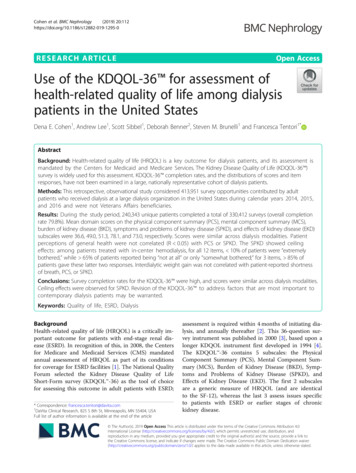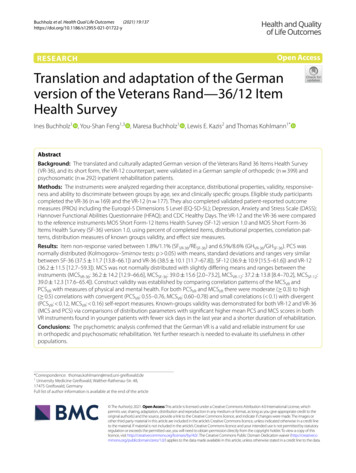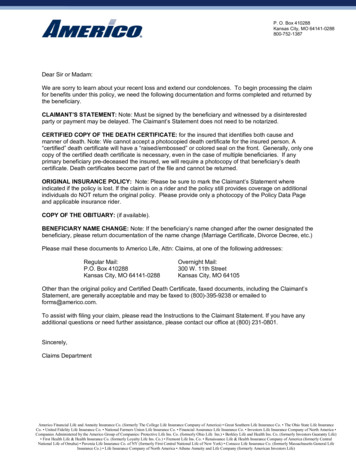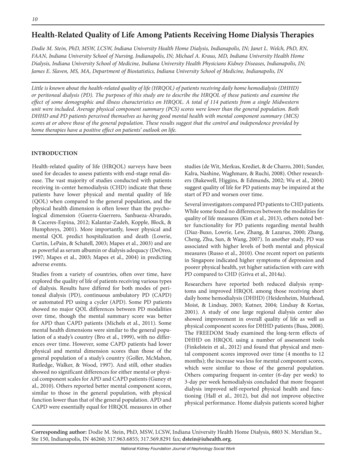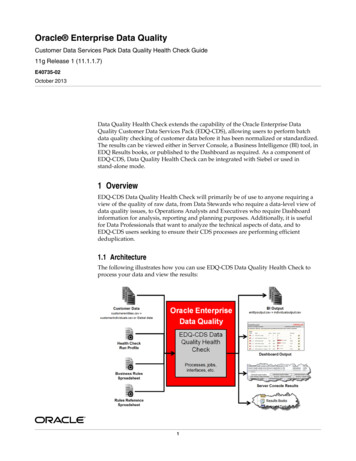
Transcription
Kennedy-Martin et al. Journal of Patient-Reported Outcomes (2018) al of PatientReported OutcomesREVIEWOpen AccessHealth-related quality of life burden ofnonalcoholic steatohepatitis: a robustpragmatic literature reviewTessa Kennedy-Martin1* , Jay P. Bae2, Rosirene Paczkowski2 and Emily Freeman2AbstractObjective: Nonalcoholic steatohepatitis (NASH) is a form of chronic liver disease (CLD): patients have an increasedrisk of developing cirrhosis, liver failure, and complications (e.g. hepatocellular carcinoma). NASH has a high clinicalburden, and likely impairs patients’ health-related quality of life (HRQoL), but there are currently no licensedtherapies. The objective of this robust pragmatic literature review was to identify and describe recent studies onthe HRQoL burden of NASH from the patient perspective.Methods: English-language primary research studies were identified that measured HRQoL in adults with NASH(population-based studies or clinical trials of pharmacological therapy). Searches were conducted in the followingbibliographical databases: MEDLINE, EMBASE, Cochrane Database of Systematic Reviews (CDSR), Cochrane CentralRegister of Controlled Trials (CENTRAL), Database of Abstracts of Reviews of Effects (DARE), and Health TechnologyAssessment Database (HTA). Abstracts from selected congresses (2015/2016) were hand searched. Articles wereassessed for relevance by two independent reviewers, and HRQoL data were extracted.Results: A total of 567 de-duplicated abstracts were identified, and 20 full-text articles were reviewed. Eight studieswere included: five quantitative, two interventional, and one qualitative. The quantitative and interventional studiesmeasured HRQoL using the Short-Form 36 (SF-36) and the Chronic Liver Disease Questionnaire (CLDQ), and thequalitative study involved focus groups and individual interviews. Overall, the studies showed that NASH affectsHRQoL, especially physical functioning, with many patients reporting being fatigued. In quantitative studies, overall,patients with NASH had a reduced HRQoL versus normative populations and nonalcoholic fatty liver disease(NAFLD) patients, but not versus chronic liver diseases. A longitudinal study showed that when weight loss wasachieved, HRQoL improvement over 6 months was greater in patients with NASH versus NAFLD. Qualitativeresearch suggested that, in addition to fatigue, other symptoms are also burdensome, having a broad negativeimpact on patients’ lives. The impact of pharmacological treatment on HRQoL was explored in only two includedstudies.Conclusions: HRQoL is impaired in patients with NASH. Patients experience a range of symptoms, especiallyfatigue, and the impact on their lives is broad. Further research is needed to understand the HRQoL burden ofNASH (e.g. assessing NASH-specific impacts not captured by SF-36 and CLDQ) and the impact of future NASHtherapies on HRQoL.Keywords: Chronic liver disease (CLD), Nonalcoholic steatohepatitis (NASH), Quality of life* Correspondence: tessa@kmho.co.uk1Kennedy Martin Health Outcomes Limited, 3rd Floor, Queensberry House,106 Queens Road, Brighton BN1 3XF, UKFull list of author information is available at the end of the article The Author(s). 2018 Open Access This article is distributed under the terms of the Creative Commons Attribution 4.0International License (http://creativecommons.org/licenses/by/4.0/), which permits unrestricted use, distribution, andreproduction in any medium, provided you give appropriate credit to the original author(s) and the source, provide a link tothe Creative Commons license, and indicate if changes were made.
Kennedy-Martin et al. Journal of Patient-Reported Outcomes (2018) 2:28BackgroundNonalcoholic steatohepatitis (NASH) is a form of chronicliver disease (CLD) in adults and children. Histologically,NASH is characterized by hepatic steatosis (fatty infiltration of the liver) and inflammation, with hepatocyte injury(ballooning) with or without fibrosis [1]. Patients have nocauses of secondary hepatic fat accumulation, such asexcessive alcohol consumption, use of steatogenic medication, or hereditary disorders [1, 2]. In the USA, theestimated prevalence of NASH in the general populationranges from 3% to 5% (reviewed by Vernon et al., 2011[3]). In obese individuals, the reported prevalence ofNASH is up to 56% (reviewed by Lopez-Velazquez et al.2014 [4] and in Vernon et al., 2011 [3]). Patients withNASH have an increased risk of developing cirrhosis (permanent liver damage, scarring, and dysfunction), liver failure, and complications, such as hepatocellular carcinoma(HCC) [5]. Indeed, NASH is the second leading indicationof CLD for liver transplant (LT) in the USA [6]. In ameta-analysis, the rates of liver-specific and overall mortality in patients with NASH were 11.8 and 25.6 per 1000person-years, respectively [7].Despite its clinical burden, there are currently noevidence-based licensed therapies for NASH. The WorldGastroenterology Organisation (WGO) suggests that, inpatients who fail to achieve a 5–10% weight reductionover 6 months to 1 year of lifestyle changes, experimentaltherapies may be added (such as the antioxidant, vitaminE, and the antifibrotic agent, pentoxifylline) [2]. If theseapproaches fail, the WGO recommends considering bariatric surgery before the development of cirrhosis. In patients who develop liver failure, LT can be performed;however, this may be denied to patients with morbid obesity, and, even following successful LT, NASH may stillrecur [2]. Clearly, there is an unmet medical need fornovel treatments for NASH that decrease disease progression and clinical impact.In addition to its clinical burden, NASH likely results ina high patient burden and a negative impact on patients’health-related quality of life (HRQoL) [8]. Understandingthe HRQoL impact of NASH, and the effect of experimental treatments on HRQoL, is important to inform futureresearch on the development of patient-centered outcomes and cost-effectiveness research. In this review, theconcept of HRQoL is that of a multidimensional construct, incorporating subjective self-assessment of different domains including physical, emotional, mental, andsocial functioning in the context of a disease and its treatment [9]. HRQoL is measured using validated HRQoLquestionnaires (generic or disease-specific) or is capturedthrough qualitative concept elicitation research with patients. A disease-specific HRQoL questionnaire that iscommonly used in patients with CLD is the Chronic LiverDisease Questionnaire (CLDQ) [10]. The CLDQ is aPage 2 of 14validated 29-item questionnaire that measures HRQoL insix domains (Abdominal symptoms, Fatigue, Systemicsymptoms, Activity, Emotional functioning, and Worry),with patients rating the frequency of clinical symptomsand emotional problems with CLD.The objective of this literature review was to identifyand describe studies on the HRQoL burden of NASHfrom the patient perspective. Studies of interest were:(1) population-based studies (quantitative and qualitative) assessing HRQoL in patients with NASH; and (2)clinical trials assessing the HRQoL impact of (unlicensed)pharmacological therapies for NASH.MethodsA search protocol was developed to guide the development and completion of the literature review. It outlinedinformation on the proposed approach, the objective, thesearch strategy, study selection criteria, data extractionmethod, and data synthesis methods. The development ofa search protocol reduces the impact of review authors’biases, ensures transparency and accountability, and maximizes the chances of correct data extraction.Study selection criteriaIncluded in the review were English-language primaryresearch studies that measured HRQoL in adults withNASH. Studies could be population-based studies (quantitative and qualitative) or clinical trials of pharmacologicaltherapy. The quantitative measurement of HRQoL couldinclude the use of generic and/or disease-specific HRQoLinstruments. Journal articles were included if they werepublished from 2006 to June 2016, and congress abstractsif they were disclosed at the most recent meetings (2015/2016).Studies were excluded if they were not specificallyin patients with NASH; if they reported an outcomesuch as disability, depression, or physical functioningas opposed to the multi-dimensional construct ofHRQoL; or if they were clinical trials on nondrugtreatment (e.g. diet, exercise, or bariatric surgery). Reviews, discussion papers, letters, and editorials werealso excluded.Information sourcesSearches were conducted in in the following bibliographicdatabases for this review: MEDLINE, EMBASE, CochraneDatabase of Systematic Reviews (CDSR), Cochrane Central Register of Controlled Trials (CENTRAL), Databaseof Abstracts of Reviews of Effects (DARE), and HealthTechnology Assessment Database (HTA). In addition, thereference lists of identified studies were checked.The abstracts presented at the most recent meetings ofvarious congresses were searched for relevant studies: International Society for Pharmacoeconomics and Outcomes
Kennedy-Martin et al. Journal of Patient-Reported Outcomes (2018) 2:28Research (ISPOR) – both European and international meetings (International 2016; Asia 2016; Europe 2015; LatinAmerica 2015); International Society for Quality of LifeResearch (ISOQOL) (2015); International Liver Congress,organized by the European Association for the Study ofthe Liver (EASL) (2016); The Liver Meeting, organized bythe American Association for the Study of Liver Diseases(AASLD) (2015); and the Asian Pacific Association for theStudy of the Liver (APASL) (2016).Search strategyThe literature review is considered to be a robust pragmaticreview rather than a systematic review. The approach isrobust in that a research plan was developed, a range ofbibliographic sources were interrogated, and there was adouble abstract review and quality control. However, not allelements were defined a priori, and the review allowed thescope to evolve in terms of focus.The base search strategy was developed for PubMed,and this syntax was then adapted for the other databases. The search strategies are provided in the Supplement. To remove duplicates, the titles and abstracts ofbibliographic records were downloaded and importedinto EndNote bibliographic software. The titles andabstracts of the search results were assessed for relevance by two independent reviewers. Studies that met(or could meet) the eligibility criteria were selected formore detailed assessment using the full text. Exclusioncodes were assigned at the full text review stage only. Incases of disagreement, both reviewers discussed the record to reach consensus.Data extraction tables were designed and then populated for all included studies by one reviewer with quality checking undertaken for 10% of records. Information(e.g. study objectives, country, study design, treatments[if relevant], patient population and numbers, HRQoLinstruments, and study findings) were included in thedata extraction tables.ResultsThe literature search yielded a total of 567 de-duplicatedabstracts, and 20 full-text articles were reviewed forrelevance. Three additional records were identified: twofrom manual checking of reference lists, and one relevant conference abstract. A total of eight studies weresuitable for inclusion in the final literature review (Fig. 1).There were five quantitative studies [8, 11–14], twointerventional trials [15, 16], and one qualitative study[17]. A summary of the HRQoL -related study objectivesand methods is provided below. The HRQoL findingsare then described, divided by study type (quantitative,interventional, and qualitative).Page 3 of 14Objectives and methods of the included studiesTable 1 summarizes the study objectives, methods,setting, and HRQoL tools in the eight included studies.All of them were primary research studies that includedmeasurement of HRQoL burden, from the patient perspective, in adults with NASH. The focus of the studiesvaried: the majority (four of five) of the quantitativestudies compared patients with NASH versus other populations (normative, other CLD, nonalcoholic fatty liverdisease [NAFLD]), with one study looking at the impactof weight loss on HRQoL. The two interventional studies assessed the impact of treatment on HRQoL and thequalitative study sought to understand NASH-relatedsymptoms and impacts on daily life.Two validated HRQoL questionnaires—the genericShort-Form 36 (SF-36) instrument [18, 19] and thedisease-specific CLDQ instrument [10]—emerged as frequent choices in the five quantitative studies. The studyby Sayiner et al. (2016) [13] also used SF-36 results to derive Short-Form Six-Dimension (SF-6D) health utilityscores. The design was cross-sectional in four studies [8,11–13] and longitudinal in one study [14]. In general, thecross-sectional quantitative studies compared HRQoL inpatients with NASH versus normative populations [12,13], patients with NAFLD [8, 13], and patients with CLDs[11]. The longitudinal study focused on the impact ofweight loss (defined as 5% weight loss) on HRQoL over6 months in NAFLD patients with and without NASH[14]. The five quantitative studies were conducted in theUSA, except for Alt et al. (2016) [11], which was conducted in Germany.The two interventional trials assessed the HRQoL impact (using SF-36 as a secondary outcome) of unlicensedNASH treatments versus placebo [15, 16]. The trial bySanyal et al. (2010) [16] was a phase 3 trial called Pioglitazone versus Vitamin E versus Placebo for the Treatmentof Nondiabetic Patients with Nonalcoholic Steatohepatitis(PIVENS), conducted in the USA. It compared the changein HRQoL in NASH patients randomized to daily pioglitazone 30 mg (n 80), vitamin E 800 IU (n 84), or placebo(n 83) for 96 weeks. The trial by Chande et al. (2006)[15] was a very small pilot study conducted in Japan thatcompared the change in HRQoL in NASH patientsrandomized to an herbal medicine (Yo Jyo Hen Shi Ko[YHK], two 250 mg tablets three times daily) or placebofor 8 weeks.In the qualitative research study, the objective was todevelop a conceptual framework to measure NASH-specificsymptoms and impacts [17]. The study was conducted inNorth America, Europe, South America, and Australasiaaccording to the US Food and Drug Administration(FDA) Patient Reported Outcomes Guidance [20]. Patients with NASH took part in focus groups and individualinterviews. From semi-structured discussions (in patients’
Kennedy-Martin et al. Journal of Patient-Reported Outcomes (2018) 2:28Page 4 of 14Fig. 1 PRISMA flow diagram of search results. aSanyal et al., 2010 [16] (from an excluded paper). bSayiner et al. 2016 [13] (from gray searches).cPalsgrove et al. 2016 [17] (conference abstract from ISPOR 2016). HRQoL, health-related quality of life; PRISMA, Preferred Reporting Items forSystematic Reviews and Meta-Analysesnative languages), the investigators obtained concepts ofNASH-related symptoms and impacts on functioning indaily life. The findings were collated, and the achievedconcept saturation was analyzed with qualitative analysissoftware. Saturation was defined as the point at which nonew concepts were noted by subsequent sessions. Finally,concepts were grouped into hypothesized domains, whichthe study authors plan to use to guide the development ofa NASH-specific PRO instrument [17].Patient populations in the included studiesTable 2 summarizes the patient populations in the included studies. The patient populations varied among thestudies. The number of patients with NASH ranged from29 [11] to 436 [8] in the five quantitative studies, eight[15] to 247 [16] in the two interventional trials, and was132 in the qualitative research study [17]. NASH diagnosisincluded biopsy, with two exceptions. In the study comparing HRQoL in patients with NASH versus patientswith other nonviral CLDs by Alt et al. (2016) [11], 81/150(54%) of the nonviral CLD patients (described below) hadbiopsy results, but the authors did not state whether thisincluded all 29 NASH patients. The qualitative study enrolled patients with a self-reported NASH diagnosis froma healthcare provider [17].There were five single-center studies [11–13, 15, 17],two multicenter studies [8, 16], and one NAFLD registrystudy [14]. Four of the studies only enrolled patients withNASH [12, 15–17]. Three studies [8, 13, 14] enrolled patients with both NAFLD and NASH. In the NASH CRNstudy by David et al. (2009) [8], a ‘NAFLD cohort’ included patients from simple steatosis to cirrhosis, and wasdivided into definite NASH (61% of patients), borderlineNASH (20%), or definitely not NASH (19%). HRQoL wascompared in ‘NAFLD’ patients with and without definiteNASH. In the study by Sayiner et al. (2016) [13], patientswith NAFLD were divided into two groups, cirrhoticNAFLD and noncirrhotic NAFLD; those patients with
ObjectiveAssess HRQoL in patients with NASH andcompare NASH vs normative US dataaCompare HRQoL in patients with NAFLD (withand without NASH) vs normative US populationCompare HRQoL in patients with cirrhotic NAFLDvs those with noncirrhotic NAFLD and also vs thegeneral populationAssess HRQoL changes from baseline to 6 months Prospective, longitudinal (6-month) registryin NAFLD and NASH patients with and withoutstudysignificant weight lossChawla et al.,2016 [12]David et al.,2009 [8]Sayiner et al.,2016 [13]Tapper and Lai,2016 [14]USAUSAGermanyCountriesMAXQDA Plus (VERBI GmbH,Berlin, Germany)NRNRJMP Pro statisticaldiscovery (V.11; SASInstitute Inc., Cary, NC, USA)CLD, chronic liver disease; CLDQ, Chronic Liver Disease Questionnaire; HRQoL, health-related quality of life; NAFLD, nonalcoholic fatty liver disease; NASH, nonalcoholic steatohepatitis; NR, not reported; PRO, patientreported outcome; RCT, randomized controlled trial; SF-36, Short-Form 36; SF-6D, Short-Form Six-Dimension; YHK, Yo Jyo Hen Shi KoaThe primary aim of the study by Chawla et al. (2016) was to assess the reliability and validity of the CLDQ (vs the SF-36) in patients with NASH: CLDQ was found to be a reliable and valid disease-specific HRQoLmeasure in adults with NASHbThere are no licensed therapies for NASHUndertake qualitative research to inform thedevelopment of a conceptual model as part ofthe process of developing a NASH-specific PROQualitative study (focus groups and individual North America,Qualitative methodsinterviews)Europe, SouthAmerica, AustralasiaSF-36USAAssess the change in HRQoL (secondary outcome) Prospective, longitudinal (96-week),from baseline to the end of 96 weeks’ treatmentrandomized, double-blind, placebo-controlled,with pioglitazone, vitamin E, or placebo in patients multicenter, phase 3 clinical trialwith NASH (without DM)Sanyal et al.,2010 [16]CLDQSF-36Palsgrove et al.,2016 [17]NRSAS V.8.2 (SAS InstituteInc., Cary, NC, USA)SF-36 (and SF-6D health SAS (SAS Institute Inc., Cary, NC,utility scores derived)USA)SF-36SF-36, CLDQDetermine the effects of an herbal medicine (YHK) Prospective, longitudinal (8-week),Japanversus placebo for 8 weeks on HRQoL (secondary randomized, double-blind, placebo-controlled,outcome) in patients with NASH and persistentlysingle-center, pilot studyelevated transaminasesQualitative research in patients with NASHQualitative analysissoftwareCLDQ (German version) IBM SPSS Statistic V.21.0(IBM Corp., Armonk, NY)Tools or method ofcapturing HRQoLChande et al.,2006 [15]Interventional trials reporting HRQoL impact of pharmacological therapies for NASHbUSAProspective, cross-sectional, single clinic study USARetrospective, cross-sectional, eight-centerstudy (database and RCT data)Prospective, cross-sectional, singleclinic studyEvaluate HRQoL in patients with CLD and inCLD patients divided by etiology, including NASHRetrospective, cross-sectional, single-centerstudyStudy designAlt et al., 2016[11]Quantitative studies reporting HRQoL in patients with NASHReferenceTable 1 NASH study objectives, methods, setting, and HRQoL tools/methods in the included studiesKennedy-Martin et al. Journal of Patient-Reported Outcomes (2018) 2:28Page 5 of 14
Patient populationOutpatients with noninfectious CLD of different etiologies(including NASH) who were referred to the outpatientclinic of the University Medical Centre of the JohannesGutenberg University Mainz (excluded malignant disease,previous LT)Adults referred for the evaluation of histology-provenNASH at Mayo Clinic, Rochester (excluded cirrhosis, biliaryobstruction)Adults with NAFLD ( 5% steatosis) and complete biopsyresults, from two NASH CRNc studies: (1) the NAFLDDatabase (observational cohort study); and (2) the PIVENStrialPatients with an established histological diagnosis ofNAFLD with or without cirrhosis. Patients with viralhepatitis, with significant alcohol intake ( 20 g/day formen, 10 g/day for women), and with other causes ofCLD were excludedPatients with NAFLD enrolled in a NAFLD registry (BethIsrael Deaconess Medical Center, Boston, MA) (Excludedother CLDs and daily consumption of 20 g alcohol)Alt et al., 2016 [11]Chawla et al., 2016 [12]David et al., 2009 [8]Sayiner et al., 2016 [13]Tapper and Lai, 2016 [14]Quantitative studies reporting HRQoL in patients with NASHReferenceTable 2 Patient populations in the included studiesBiopsy (NAS 5–8)BiopsyNAFLD with cirrhosis n 30dMean age 54.1 y (SD 10.8)Males 56.7%NAFLD without cirrhosis n 59Mean age 49.1 y (SD 10.4)Males 37.3%NAFLD n 151NASH n 67 (44%)Advanced fibrosis n 30 (20%) [Age notreported for NASH patients]No significant weight loss achieved n 104NASH n 42 (44%)Mean NFS –1.41 (SD 1.80)Mean FIB-4 index 1.47 (SD 0.99)Advanced fibrosis n 20 (20%)Significant weight loss achieved n 47NASH n 25 (54%)Mean NFS –1.95 (SD 1.62)Mean FIB-4 index 1.29 (SD 0.80)Advanced fibrosis n 10 (21.7%)BiopsyBiopsy(1) Abnormal serum liver tests for 3 months; (2)liver histology revealing 10% steatosis and lobularinflammation with or without fibrosis; (3) exclusionof alternate CLD etiologies; (4) history of alcoholconsumption 40 g/day (men) or 30 g/day(women); (5) no clinical or biochemical evidencefor cirrhosisCLD etiology (including NASH) determined clinicallyand by biopsyBiopsy n 81 (54%)How NASH was diagnosed/confirmedNAFLD n 713Definite NASH n 436 (61%)Borderline NASH n 141 (20%)Definitely not NASH n 136 (19%)Definite NASH n 436Mean age 49.3 y (SD 11.9)Males 33.0%Cirrhosis, n 49 (11.2%)NASH n 79Mean age 46 y (SE 11)Males 35%Age-and gender-matched US populationsample, n 2474aMean age 46 yMales 39%Normative data for healthy controlsbCLD n 150NASH n 29 (19.3%)NAFLD n 25 (16.7%)NASH n 29Median age 52 y (range 24–76)Males 48.3%Cirrhosis, n 10 (34.5%)Patient numbersKennedy-Martin et al. Journal of Patient-Reported Outcomes (2018) 2:28Page 6 of 14
Patient populationAdults without DM with NASH. Definite or possiblesteatohepatitis with an activity score of 5, or definitesteatohepatitis with an activity score of 4. A score of 1for hepatocellular ballooning was required. (Excludedcirrhosis, other CLDs, alcohol consumption [ 20 g/daywomen; 30 g/day men] for 3 consecutive monthsduring the previous 5 y; receipt of drugs known tocause steatohepatitis)Sanyal et al. 2010 [16]Patients ( 18 y) with NASH, recruited through localclinicians and disease support groupsNASH n 132eMean age 50.2 yMales 47%Self-reported cirrhosis n 17 (13%)NASH n 247Mean age 46.3 y (SD 11.9)Males 40%Pioglitazone n 80Vitamin E n 84Placebo n 83(Cirrhosis excluded)NASH n 8YHK group n 5Mean age 56 y (SD 7)Males 20%Placebo group n 3Mean age 47 y (SD 12)Males 67%Cirrhosis status not statedPatient numbersSelf-reported diagnosis of NASH from a healthcareproviderBiopsyBiopsyHow NASH was diagnosed/confirmedALT, alanine aminotransferase; AST, aspartate aminotransferase; CLD, chronic liver disease; DM, diabetes mellitus; FIB-4, Fibrosis-4 [index]; GI, gastrointestinal; LT, liver transplant; NAFLD, nonalcoholic fatty liver disease;NAS, NAFLD Activity Score; NASH, nonalcoholic steatohepatitis; NFS, NAFLD Fibrosis Score; PIVENS, Pioglitazone versus Vitamin E versus Placebo for the Treatment of Nondiabetic Patients with NonalcoholicSteatohepatitis [trial]; YHK, Yo Jyo Hen Shi KoaWare JE Jr. SF-36 Health Survey manual and interpretation guide. Boston: The Health Institute, New England Medical Centre, 1993bBondini S, Kallman J, Dan A, Younoszai Z, Ramsey L, Nader F, Younossi ZM (2007) Health-related quality of life in patients with chronic hepatitis B. Liver Int 27:1119–1125cThe multicenter study by David et al. (2009) derived baseline HRQoL data (SF-36) from two studies conducted by the Nonalcoholic Steatohepatitis Clinical Research Network (NASH CRN), comprising a total of eightclinical centers and a central data coordinating center. It was established by the National Institute of Diabetes and Digestive and Kidney Diseases (NIDDK) to assess the natural history, pathogenesis, and therapy ofNAFLD in the USA. The first study in David et al. (2009) was a NAFLD Database (observational cohort study), and the second was a randomized controlled trial (Pioglitazone versus Vitamin E versus Placebo for theTreatment of Nondiabetic Patients with Nonalcoholic Steatohepatitis [PIVENS])dPatients with cirrhotic NAFLD in Sayiner et al. (2016) were considered in this literature review to represent NASHeIn the qualitative study (Palsgrove et al. 2016), the data in this review have been taken from the conference poster in which the patient number is 132. In the conference abstract, the patient number is 135Palsgrove et al. 2016 [17]Qualitative research in patients with NASHAdults (18–75 y) with NASH and persistently ( 3 months)abnormal ALT and/or AST. (Excluded overuse of alcohol[20 g/week]; other CLDs or other hepatic, GI, renal,cardiovascular, neurological, or hematological disorder;receipt of herbal treatments or dietary supplementsexcept multivitamins/minerals)Chande et al. 2006 [15]Interventional trials reporting HRQoL impact of pharmacological therapies for NASHReferenceTable 2 Patient populations in the included studies (Continued)Kennedy-Martin et al. Journal of Patient-Reported Outcomes (2018) 2:28Page 7 of 14
Kennedy-Martin et al. Journal of Patient-Reported Outcomes (2018) 2:28cirrhotic NAFLD were considered in this literature reviewto represent NASH. In the longitudinal study by Tapperand Lai (2016) [14], 151 patients with NAFLD (n 67 withNASH) were divided at 6 months according to those whoachieved significant weight loss (defined as 5% reduction: n 47; n 25 with NASH) and those withoutsignificant weight loss (n 104; n 42 with NASH).As mentioned above, the study by Alt et al. (2016)[11] enrolled patients with nonviral CLDs of differentetiologies: cholestatic liver disease (23% of patients),autoimmune hepatitis (21%), NASH (19%), NAFLD(17%), alcoholic liver disease (ALD; 10%), cryptogenic(5%), and ‘other’ (5%).The rate of cirrhosis in the patients with NASH wasgenerally low. In the quantitative studies, the rate of cirrhosis in NASH patients was zero in Chawla et al.(2016) [12], 11% in David et al. (2009) [8], and 35% inAlt et al. (2016) [11]. Chawla et al. (2016) [12] statedthat most of the NASH patients had mild-to-moderatehistological involvement with NASH. In Sayiner et al.(2016) [13], as mentioned above, those patients with cirrhotic NAFLD were considered to represent NASH;thus, all the NASH patients had cirrhosis. However, ofthe cirrhotic NAFLD patients, 73% had mild disease(Child–Turcotte–Pugh class A). The phase 3 interventional trial [16] excluded patients with cirrhosis, and theauthors of the small pilot, interventional trial [15] didnot report cirrhosis status. In the qualitative researchstudy, 13% of the NASH patients reported that they hadcirrhosis [17].Quantitative study findingsOverall, the cross-sectional quantitative studies showedthat patients with NASH had a reduced HRQoL versusnormative populations [12, 13] and versus patients withNAFLD [8, 13]. However, in one study [11], patientswith NASH did not have a reduced HRQoL versus patients with CLDs (cholestatic liver disease, autoimmunehepatitis, NAFLD, ALD, cryptogenic, and ‘other’). Thefindings of these five studies are described in more detailbelow.In the two studies comparing NASH patients versusnormative data, patients with NASH had significantlyreduced HRQoL, including generic SF-36 [12, 13] andCLD-specific CLDQ [12] as well as health utilities(SF-6D) [13]. In the study by Sayiner et al. (2016) [13],HRQoL scores were significantly lower in cirrhoticNAFLD patients (considered in this literature review torepresent NASH) versus the general population, forSF-36 (all eight domains as well as mental componentsummary [MCS] and physical component summary[PCS]) and SF-6D health utilities (Fig. 2). In the studyby Chawla et al. (2016) [12], patients with NASH hadsignificant impairments in all SF-36 domains versus anPage 8 of 14age- and gender-matched US population. This was seenin all eight domains (all p 0.05) as well as the PCS andMCS scores (both p 0.02), and in all six CLDQ domains (p 0.0001). A multivariate analysis showed thatSF-36 MCS and PCS scores were independent of age,sex, body mass index (BMI; 30 kg/m2, i.e. obesity),and fibrosis stage, but that in patients with type 2 diabetes mellitus (T2DM) there was a significant reductionin the SF-36 PCS score (37 vs 45; p 0.04). Analysis ofselected variables showed that CLDQ total scores wereindependent of age, sex, BMI, and fibrosis stage, butthat in patients with T2DM there was a significant reduction in CLDQ total score (4.1 vs 5.1; p 0.01) [12].In the two studies comparing patients with NASHversus NAFLD [8, 13], SF-36 scores were significantlyreduced for all domains, except for the MCS score inthe large NASH CRN study by David et al. (2009) [8].In the NASH CRN study, patients with NASH hadsignificantly lower HRQoL than NAFLD patients wit
Tessa Kennedy-Martin1*, Jay P. Bae2, Rosirene Paczkowski2 and Emily Freeman2 Abstract Objective: Nonalcoholic steatohepatitis (NASH) is a form of chronic liver disease (CLD): patients have an increased . or bariatric surgery). Re-views, discussion papers, letters, and editorials were also excluded. Information sources Searches were conducted .
